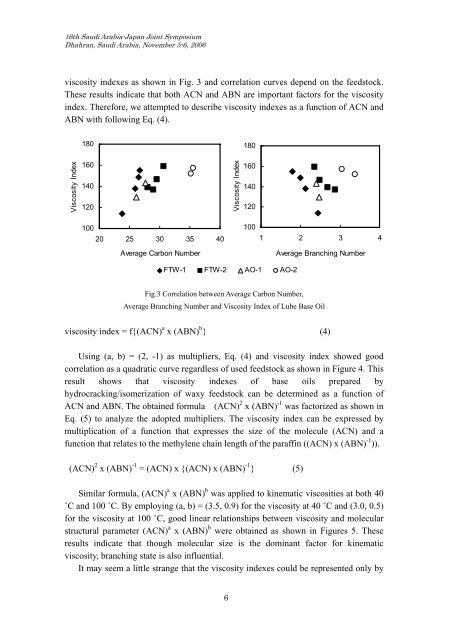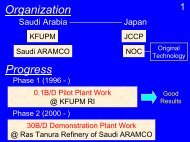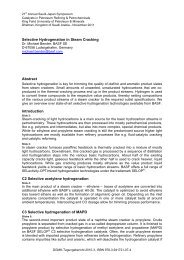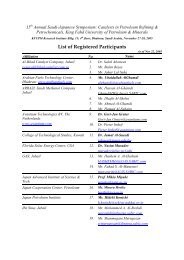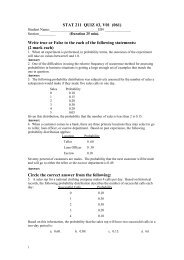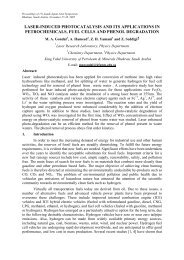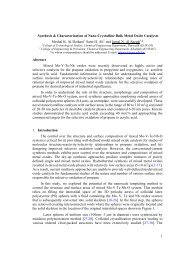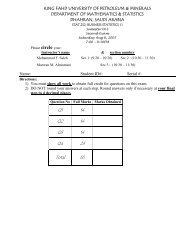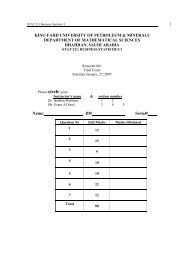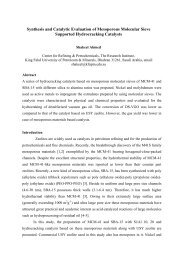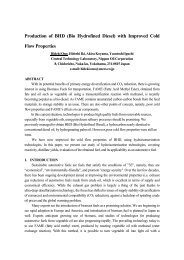Performance & Molecular Structure of Fuel Oils & Lube Base Oils ...
Performance & Molecular Structure of Fuel Oils & Lube Base Oils ...
Performance & Molecular Structure of Fuel Oils & Lube Base Oils ...
Create successful ePaper yourself
Turn your PDF publications into a flip-book with our unique Google optimized e-Paper software.
16th Saudi Arabia-Japan Joint SymposiumDhahran, Saudi Arabia, November 5-6, 2006viscosity indexes as shown in Fig. 3 and correlation curves depend on the feedstock.These results indicate that both ACN and ABN are important factors for the viscosityindex. Therefore, we attempted to describe viscosity indexes as a function <strong>of</strong> ACN andABN with following Eq. (4).180180Viscosity Index160140120Viscosity Index16014012010020 25 30 35 401001 2 34Average Carbon NumberAverage Branching NumberFTW-1 FTW-2 AO-1 AO-2Fig.3 Correlation between Average Carbon Number,Average Branching Number and Viscosity Index <strong>of</strong> <strong>Lube</strong> <strong>Base</strong> Oilviscosity index = f{(ACN) a x (ABN) b } (4)Using (a, b) = (2, -1) as multipliers, Eq. (4) and viscosity index showed goodcorrelation as a quadratic curve regardless <strong>of</strong> used feedstock as shown in Figure 4. Thisresult shows that viscosity indexes <strong>of</strong> base oils prepared byhydrocracking/isomerization <strong>of</strong> waxy feedstock can be determined as a function <strong>of</strong>ACN and ABN. The obtained formula (ACN) 2 x (ABN) -1 was factorized as shown inEq. (5) to analyze the adopted multipliers. The viscosity index can be expressed bymultiplication <strong>of</strong> a function that expresses the size <strong>of</strong> the molecule (ACN) and afunction that relates to the methylene chain length <strong>of</strong> the paraffin ((ACN) x (ABN) -1 )).(ACN) 2 x (ABN) -1 = (ACN) x {(ACN) x (ABN) -1 } (5)Similar formula, (ACN) a x (ABN) b was applied to kinematic viscosities at both 40˚C and 100 ˚C. By employing (a, b) = (3.5, 0.9) for the viscosity at 40 ˚C and (3.0, 0.5)for the viscosity at 100 ˚C, good linear relationships between viscosity and molecularstructural parameter (ACN) a x (ABN) b were obtained as shown in Figures 5. Theseresults indicate that though molecular size is the dominant factor for kinematicviscosity, branching state is also influential.It may seem a little strange that the viscosity indexes could be represented only by6


